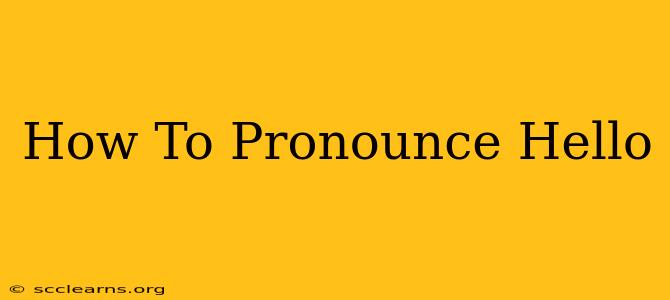Learning to say "hello" in different languages is a great way to connect with people from around the world. But even within a single language, pronunciation can vary. This guide will help you master the pronunciation of "hello" in several common languages and explore some regional variations.
English Pronunciation of "Hello"
The English pronunciation of "hello" is relatively straightforward, but nuances exist depending on accent and region.
Breaking Down the Sounds:
- h: A voiceless aspirated consonant. Think of the breathy sound at the beginning of "hat."
- e: A short, open "e" sound, similar to the "e" in "bed."
- l: A liquid consonant, pronounced with the tongue touching the alveolar ridge (the bumpy part behind your upper teeth).
- o: A long "o" sound, as in "go."
- /ˈhɛˈloʊ/: This is the phonetic transcription, showing the stress on both the first and second syllables.
Regional Variations:
While the basic pronunciation is consistent, subtle differences exist:
- American English: Tends to have a slightly more relaxed pronunciation, with the "l" sound sometimes less pronounced.
- British English: Often features a more precise and formal pronunciation, with a clearer "l" sound.
- Australian English: Can have a broader "o" sound, similar to the "o" in "caught."
Pronouncing "Hello" in Other Languages
Let's explore how to say "hello" in a few other popular languages. Remember that these are just approximations, and listening to native speakers is crucial for accurate pronunciation.
Spanish: "Hola" (/ˈo.la/)
- o: A long "o" sound, similar to the "o" in "go."
- l: A single "l" sound.
- a: A short "a" sound, like in "father."
The stress is on the first syllable.
French: "Bonjour" (/bɔ̃ʒuʁ/)
- bɔ̃: This is a nasal sound, combining "b" and "on" sounds, without a clear "o" sound.
- ʒuʁ: The "ʒ" sound is a voiced postalveolar fricative (like "s" but softer and further back in the mouth). The "u" is a rounded vowel. The "r" sound is a uvular r (a sound made in the back of the throat).
This requires practice to master the nasal and uvular sounds accurately.
German: "Hallo" (/ˈhaloː/)
- H: Similar to the English "h."
- a: A short "a" sound, similar to the "a" in "father."
- l: Similar to the English "l."
- o: A long "o" sound, similar to the "o" in "go," but slightly more open.
Italian: "Ciao" (/ˈtʃa.o/)
- tʃ: This is a palatal affricate sound, combining "ch" as in "cheese" and "j" as in "jump"
- a: Similar to the short "a" sound in "father"
- o: A short "o" sound similar to the "o" in "hot."
The stress is on the first syllable.
Tips for Mastering Pronunciation
- Listen to native speakers: The best way to learn is by listening to audio and video resources.
- Repeat and practice: Mimic the sounds you hear and practice regularly.
- Use pronunciation guides: Phonetic transcriptions (like those included above) can be helpful.
- Record yourself: This allows you to identify areas for improvement.
- Don't be afraid to make mistakes: Everyone makes mistakes when learning a new language. Keep practicing and you will improve.
By following these tips and practicing regularly, you can confidently pronounce "hello" in various languages and dialects. Learning to greet people in their native tongue is a great way to show respect and build connections.

